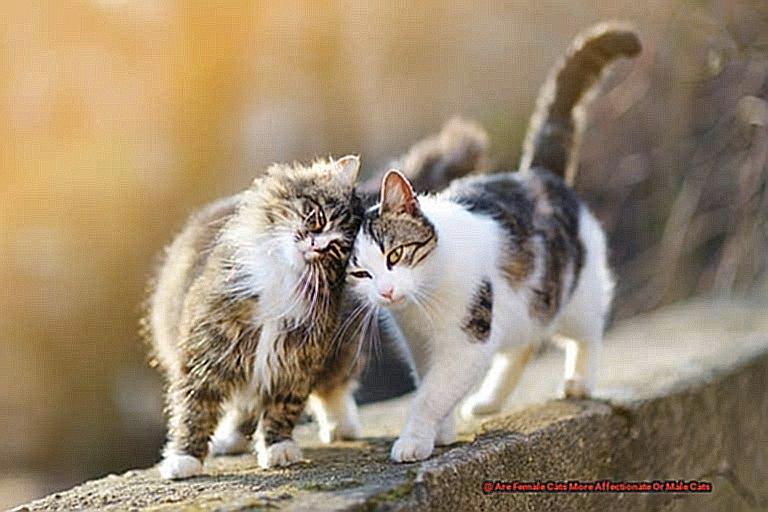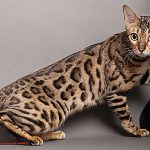Let’s dive headfirst into the age-old debate that has been keeping us up at night – are female cats really more affectionate than their male counterparts? Now, I know we all have our own opinions on this matter, but before we start throwing hairballs at each other, let’s take a closer look at the fascinating world of feline behavior.
We’ve all experienced those heart-melting moments when our furry friends curl up in our laps or give us those adorable head boops that make us feel like the luckiest humans on Earth. But do these acts of affection differ between female and male cats? Some folks swear by their lovey-dovey female companions, while others claim that their macho male buddies are just as cuddly.
So, grab your favorite cat-shaped mug filled with hot cocoa (or maybe some catnip tea if you’re feeling adventurous), and join me as we embark on a journey to unravel the truth behind the affectionate tendencies of our beloved feline friends. Get ready for a rollercoaster ride filled with purrs, tail flicks, and enough cuteness to make even Grumpy Cat crack a smile.
Are female cats more affectionate or male cats
While there may be some generalizations, it’s crucial to understand that individual cat personalities can greatly influence their level of affection. Let’s delve into the topic and separate fact from fiction.
Nurturing Nature:
Female cats are often seen as more affectionate due to their instinctual maternal instincts. Their nurturing nature can manifest as cuddling, purring, and seeking physical contact with their owners. However, it’s important to note that not all female cats display these behaviors, and some may have a more independent streak.
Unique Expressions of Love:
Male cats may be perceived as less affectionate, but they have their own unique ways of showing love. Head-butting, rubbing against their owners, or kneading with their paws are all signs of affection and attachment. These expressions may not be as overtly cuddly as those of female cats, but they are heartfelt gestures nonetheless.
Individual Differences:
Just like humans, each cat has its own personality. Factors such as upbringing, socialization, and past experiences play a significant role in determining a cat’s level of affection towards humans. A male cat that has been well-socialized from a young age can be just as affectionate as a female cat.
The Two-Way Street:
Building a strong bond with your cat requires time and effort from both sides. The amount of love and attention you invest in your feline friend can greatly impact their level of affection towards you. Remember to respect your cat’s individual temperament and preferences when it comes to displaying affection.
The Physical Attributes of Female and Male Cats
The eternal debate – are male cats or female cats better? Well, my feline-loving friends, I’m here to shed some light on the physical attributes that set these two genders apart. While both female cats, also known as queens, and male cats, or toms, are equally lovable and adorable, they do have a few notable differences in their appearance. So let’s dive right in and explore the wonderful world of cat anatomy.
Head and Body Proportions
When it comes to head size, it’s all about the ladies. Female cats often have smaller and more delicate facial structures. Their heads are rounded and petite, giving them a dainty and feminine look. On the other paw, male cats tend to sport a broader head with a more pronounced jawline and cheekbones. It’s like having a feline version of Arnold Schwarzenegger strutting around your house.
Body Build
Ladies first. Female cats have a slender and sleek physique, making them look like graceful ballerinas of the cat world. They have a narrower waist and exhibit a more streamlined appearance overall. Now, let’s take a moment to appreciate the gentlemen – male cats boast a bulkier and more muscular build. They have thicker necks, broader shoulders, and an overall powerful and sturdy presence. Talk about being “built like a tomcat”.
The Telling Tale of Genitalia
Now, this might be a bit sensitive for some readers, but we can’t ignore this important aspect of feline anatomy. Female cats have a small vertical slit located beneath their tail – that’s their vulva. Meanwhile, male cats possess two distinctive features: the scrotum, which contains the testicles and is located between their hind legs (think cat boxer shorts), and the penis sheath above it. So if you ever find yourself wondering, “is it a boy or a girl?”, just take a peek in the nether regions.
Fur-tastic Variety
When it comes to fur, both female and male cats can rock various styles. Whether they have short hair or long flowing locks, it’s all about genetics, not gender. So whether your cat’s coat is sleek and shiny or fluffy and luxurious, it’s just another way they express their unique personality.
Remember, these physical attributes can vary between individual cats due to factors like breed, genetics, and overall health.
So, don’t be surprised if you come across a petite male cat or a muscular female cat – diversity is the spice of life.
Understanding these physical differences can be helpful in identifying your cat’s gender accurately. It’s especially crucial when distinguishing intact males from females or discussing breeding or reproductive health concerns.
Understanding the Instinctual Nature of Female Cats
Female cats possess an instinctual nature that is as mysterious as it is captivating. Join me on this journey as we delve into the depths of their primal instincts and unravel the secrets behind their behavior.
The Call of Motherhood: Reproduction and Care
At the core of a female cat’s instinctual nature lies her yearning to reproduce and care for her offspring. This innate drive compels her to seek out mates and create a safe haven for her kittens. You’ll witness her maternal instincts come to life through acts of grooming, nursing, and teaching her young ones essential life skills.
Nurturing and Protective: A Mother’s Love
Female cats are renowned for their nurturing and protective nature. They go above and beyond to ensure the safety and well-being of their brood. Their motherly love shines through as they shower their kittens with affection and tenderness, guiding them through their early stages of life.
Territorial Tendencies: Marking Their Presence
The instinctual nature of female cats also makes them fiercely territorial beings. They mark their territory by rubbing against objects and scratching surfaces with their razor-sharp claws. This behavior serves as a form of communication, a way to announce their presence to other animals, and a warning to stay away from their domain.
Independent Spirit: Survival in the Wild
Female cats possess an unyielding sense of independence, honed through centuries of surviving in the wild. They are remarkably self-reliant and self-sufficient compared to their male counterparts. This independent spirit allows them to navigate their surroundings with finesse, ensuring their survival in even the harshest environments.
Fierce Competition: Protecting Offspring and Resources
In some instances, female cats may display aggression towards other females, especially when competing for limited resources such as food, territory, or mates. This aggression stems from their instinctual drive to protect their precious offspring and secure resources necessary for their survival.
The Dance of Estrus: A Hormonal Symphony
Ah, the enchanting dance of estrus, also known as the heat cycle. Female cats experience this unique hormonal cycle, which brings about changes in their behavior. During this period, they become more vocal, affectionate, and may exhibit enticing behaviors like rolling on the floor or rubbing against objects to attract potential mates.
Affection with a Twist: The Intermittent Bond
While female cats can be affectionate towards their human companions, their displays of affection may be more intermittent compared to male cats. Their instinctual focus is primarily on reproduction and caring for their young ones, rather than seeking constant human companionship. But fear not, dear cat lovers, for these moments of feline affection are truly special and worth cherishing.
Examining the Territorial Tendencies of Male Cats

Male cats, with their captivating charm and mysterious nature, possess territorial tendencies that set them apart from their female counterparts. Understanding these tendencies can help cat owners create a harmonious living environment for their feline companions. Let’s dive into the world of male cats and explore their territorial behaviors.
- Marking Territory: Male cats have an instinctual drive to mark their territory. They do this by spraying urine or scratching surfaces to leave their scent behind. This serves as a warning to other cats, signaling that the area is already claimed. It’s their way of saying, “Back off, this is mine.”
- Aggressive Behavior: Male cats are more likely to exhibit aggressive behavior when it comes to defending their territory. They may engage in fights with other male cats or display aggression towards humans or other animals they perceive as a threat. This is their way of protecting what they consider their own.
- Neutering and Spaying: One effective way to reduce the territorial tendencies of male cats is through neutering or spaying. This procedure lowers their production of testosterone, the hormone responsible for driving territorial behavior. Neutered male cats tend to be calmer and less prone to marking territory or engaging in aggressive behavior.
- Individual Differences: It’s important to note that not all male cats exhibit strong territorial tendencies. Some may be more laid-back and less inclined to defend their territory aggressively. Factors such as genetics, upbringing, and socialization can influence a cat’s behavior and level of territoriality.
- Female Cats: In comparison to males, female cats tend to be less territorial. They are generally more sociable and affectionate towards humans and other animals. However, it’s worth mentioning that female cats can still display some territorial behaviors when it comes to protecting their kittens or guarding resources.
Creating a Harmonious Environment:
When introducing a new cat into a household with a male cat, precautions should be taken to minimize potential conflicts over territory. Gradual introductions, providing separate resources for each cat, and ensuring enough space for both cats to have their own territories can help prevent territorial disputes.
Socialization and Early Experiences Impacting Cat Affection
Cats are known for their independence, but they can also be incredibly affectionate companions. The level of affection a cat displays towards humans is influenced by their early experiences and socialization. In this article, we will explore how these factors shape a cat’s behavior and provide tips for cat owners to foster a strong bond with their feline friends.
Socialization:
Socialization is the process of exposing kittens to various people, animals, and environments to help them develop positive associations. Here’s how it impacts a cat’s level of affection:
- Positive Early Experiences: Kittens that have positive interactions with humans from a young age are more likely to grow up to be affectionate cats. Handling them gently, engaging in play, and using positive reinforcement builds trust and strengthens the bond.
- Exposure to Diversity: It is crucial for kittens to have interactions with people of different ages, genders, and ethnicities. This helps them avoid developing biases or fear towards specific groups, leading to a more sociable and affectionate nature.
- Fear and Aggression: Cats that are not properly socialized may exhibit fearful or aggressive behaviors towards humans. They may be less likely to seek affection or enjoy human company, creating challenges in building a close relationship.
Individual Factors:
While socialization plays a significant role, individual factors also influence a cat’s affection levels:
- Genetics: Some cats may have genetic predispositions that affect their temperament and level of affection towards humans. Understanding this can help manage expectations and tailor interactions accordingly.
- Personality Traits: Just like humans, cats have unique personalities. Some cats are naturally more outgoing and affectionate, while others may be more reserved. Recognizing and respecting these differences allows for a better understanding of the cat’s needs.
Continued Socialization:
Socialization is an ongoing process that should continue throughout a cat’s life. Here are some tips for maintaining and strengthening the bond:
- Enriching Environment: Provide opportunities for mental and physical stimulation, such as interactive toys, scratching posts, and perches. This helps cats feel secure and content in their surroundings.
- Positive Reinforcement: Reward desired behaviors, such as coming when called or sitting calmly for grooming. This encourages cats to seek human interaction and reinforces their positive associations with people.
- Patience and Respect: Respect the cat’s personal space and boundaries. Give them time to approach and initiate contact, as forcing interactions can lead to stress and withdrawal.
Spaying or Neutering Can Affect a Cat’s Behavior
When it comes to your feline friend, understanding how spaying or neutering can affect their behavior is essential. As an expert in the field, I can shed some light on this topic based on research findings and personal experiences.
Decrease in Aggression
One of the most significant behavior changes seen in spayed or neutered cats is a decrease in aggression. Male cats, in particular, benefit from the removal of their testosterone, which reduces their territorial instincts and aggressive tendencies. Female cats may also exhibit less aggression after being spayed, although the change might not be as pronounced as in males.
Reduction in Spraying
Unaltered cats are known for marking their territory with urine in a behavior called spraying. This behavior is often seen as a way of communicating with other cats, asserting dominance, or attracting a mate. However, spaying or neutering can significantly reduce or even eliminate spraying behavior, making your home a more pleasant environment.
Diminished Mating-Related Behaviors
Yowling, pacing, and restlessness are common mating-related behaviors exhibited by unaltered cats who are in heat or searching for a mate. By removing their reproductive organs through spaying or neutering, these behaviors are usually diminished or eliminated entirely.
Not a Guaranteed Solution
While spaying or neutering can have positive effects on a cat’s behavior, it is important to note that it is not a guaranteed solution for all behavioral issues. Each cat is unique, and factors such as socialization, environment, and individual temperament should also be considered when addressing behavioral problems.
Health Benefits
Apart from its impact on behavior, spaying or neutering has several health benefits for cats. It helps prevent certain types of cancers and reduces the risk of reproductive disorders. Additionally, it helps control the cat population and prevents unwanted litters, contributing to the overall welfare of cats.
The Importance of Bonding with Your Cat
Creating a strong bond with your cat is not only a delightful experience but also crucial for their overall well-being. Just like humans, cats thrive on love, attention, and companionship. By investing time and effort into bonding activities, you can build a deep, trusting relationship with your furry friend. Here’s why bonding with your cat is so important:
- Builds Trust and Understanding: Spending quality time with your cat through playtime, grooming, and cuddling creates a sense of trust and mutual understanding. This allows you to better understand their needs and emotions, leading to better care and prompt attention to any issues that may arise.
- Provides Mental Stimulation: Regular bonding activities provide mental stimulation for your cat, helping to prevent boredom and destructive behavior. Engaging in interactive play or providing puzzle toys challenges their minds and keeps them entertained.
- Promotes Physical Exercise: Bonding activities often involve physical exercise, which is vital for your cat’s overall health. Play sessions using toys that mimic hunting can help keep them active and maintain a healthy weight.
- Therapeutic Benefits: Research has shown that spending time with cats can have therapeutic benefits for both humans and felines. It can reduce stress levels, lower blood pressure, and improve emotional well-being for both you and your cat.
- Fulfills Social Needs: While cats are known for their independent nature, they still crave love and attention from their owners. Bonding helps fulfill these social needs, making them feel secure and loved in their environment.
- Aids in Training and Discipline: Building a strong bond with your cat can also aid in training and discipline. When they trust and respect you, they are more likely to respond positively to commands and guidance.
Remember that every cat is unique, regardless of gender. Approach bonding with patience, respect, and understanding, allowing your cat to adjust to your presence at their own pace. Building a strong bond takes time and effort, but the rewards are immeasurable.
Common Signs of Affection from Female Cats
Understanding these common signs of affection is key to deepening your bond and ensuring your furry friend feels cherished. In this expert-level guide, we’ll unravel the mysteries behind your female cat’s gestures of love.
Grooming Galore:
When your female cat showers herself or other feline companions with meticulous grooming, it’s a clear sign of affection. This act of bonding and caring helps strengthen the social connections in your fur family.
Kneading Cuteness:
If your female cat gently pushes her paws in and out against a soft surface like a blanket or your lap, consider yourself lucky. This adorable behavior, known as kneading, is an instinctual remnant from nursing kittens and signals her love and contentment.
Head Bumps and Rubs:
When your feline friend rubs her head against you or objects around the house, she’s not only marking her territory but also showing trust and familiarity. This endearing behavior, called bunting, is a surefire sign of affection.
Purr-fect Harmony:
Ah, the melodious sound of purring. When your female cat purrs while being petted or cuddled, it’s her way of expressing deep contentment and relaxation. Soothing purrs signify that she feels safe and at ease in your presence.
Playtime Bliss:
Engaging in play behavior is another way your female cat shows her affection. Whether she brings you toys or initiates interactive play sessions, these playful moments are bonding experiences that strengthen your relationship.
Cuddle Queen:
Curling up next to you or seeking physical contact is a clear sign that your female cat adores you. When she chooses to sleep close by or even on top of you, she seeks warmth, comfort, and a deep connection.
Mesmerizing Eye Contact:
Locking eyes with your female cat can be a powerful display of affection. Prolonged eye contact indicates trust and a strong bond. So don’t shy away when those mesmerizing eyes gaze deeply into your soul.
Vocal Delights:
Soft chirping or trilling sounds are charming vocalizations that some female cats use to express their affection. You might hear these delightful sounds when they greet you or during moments of excitement and joy.
Territorial Markings:
While it may seem strange, territoriality can be an expression of love from your female cat. By rubbing against furniture or objects around the house, she’s marking them as part of her territory, creating a sense of security and belonging.
Common Signs of Affection from Male Cats
Cats have a unique way of expressing their affection, and male cats are no exception. If you’re a proud owner of a male feline companion, understanding the common signs of affection can deepen your bond and ensure your furry friend feels loved and appreciated. In this blog post, we’ll delve into the intricacies of male cat behavior and decode their language of love.
Bunting: Marking Territory with Love
Male cats often display their affection through headbutting or rubbing their scent glands against people or objects. This behavior, known as bunting, is a powerful way for them to mark their territory while showing familiarity and trust. So, if your male cat gently presses his head against you or rubs his cheek on your leg, consider it a sign of deep affection.
Kneading: A Paws-itive Expression
Have you ever noticed your male cat rhythmically pushing his paws in and out against a soft surface? This adorable behavior, called kneading, is not only a throwback to their kittenhood but also a sign of contentment and affection. By kneading on your lap or a cozy blanket, your male cat is showing that he feels safe and loved in your presence.
Close Proximity: Cuddles Speak Louder than Words
When your male cat chooses to curl up next to you or sit on your lap, it’s a clear indication of his affection. This close physical proximity signals that he trusts and feels comfortable in your presence. Some male cats may even take it a step further by joining you in bed at night, solidifying the bond between human and feline.
Vocal Delights: Purring and Meowing from the Heart
Male cats express their affection through vocalization, using purrs, meows, and other pleasant sounds. A loud purr or soft meow can indicate contentment and a desire for interaction or attention. So, when your male cat serenades you with his melodious voice, be sure to respond with love and affection.
Playfulness: Love in Motion
Playfulness is often intertwined with affection in male cats. Engaging in interactive play, chasing toys, and pouncing on moving objects are all signs that your male cat is not only having fun but also strengthening the bond between you. So, grab a toy and indulge in some playtime bliss to show him your reciprocated love.
Grooming Gestures: Licks of Love
Male cats may groom themselves excessively when they feel content and secure in their environment. But they also extend this grooming behavior to their human companions as a sign of affection. If your male cat licks your hands, hair, or face, consider it a tender gesture of love and care.
Also Read: Can Cats Eat Ketchup And Mustard
Conclusion
When it comes to the age-old debate of whether female cats are more affectionate than male cats, the answer is not so clear-cut. While some may argue that female cats tend to be more loving and nurturing, others believe that male cats can be just as affectionate, if not more. It ultimately boils down to individual personality and upbringing.
Female cats are often described as being more independent and self-reliant. They have a reputation for being strong-willed and less inclined to seek constant attention from their human companions. However, this does not mean they lack affection altogether. Female cats can still form deep bonds with their owners and show their love in subtle ways, such as rubbing against your legs or purring softly when you pet them.
On the other hand, male cats are often characterized as being more laid-back and sociable. They tend to enjoy social interactions and may be more inclined to cuddle up on your lap or sleep beside you at night. Male cats are known for their playful nature and their desire for physical contact with their loved ones.
It’s important to remember that these generalizations do not apply to every individual cat. Just like humans, each feline has its own unique personality traits that shape how they express affection. Some female cats may be incredibly affectionate while some male cats may prefer a more independent lifestyle.
Ultimately, the level of affection displayed by a cat depends on various factors including genetics, early socialization experiences, and the bond formed with its owner over time. So instead of focusing solely on gender stereotypes, it’s crucial to pay attention to your cat’s individual needs and preferences.
In conclusion, whether a female or male cat is more affectionate is subjective and cannot be definitively determined. Both genders have the potential for great love and devotion towards their human companions.







